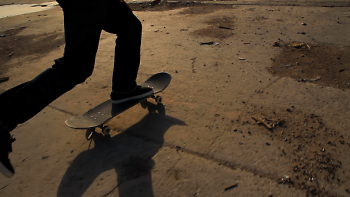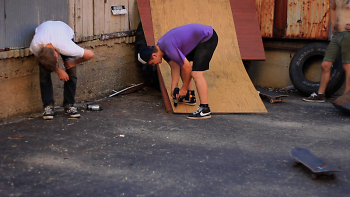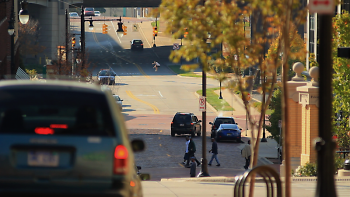Several scenes as well as Jeremy Knickerbocker's narration highlight the way skateboarding is an art form in his film "Space for Rent."
The film's title comes from the nature of skateboarding and its interactions with architecture, says Knickerbocker.
"I titled the film 'Space For Rent' because it seeks to convey, briefly, not only the ways that skateboarding is an art form, but also the significance that it holds when applied to particular architectural spaces," he says. "The spaces that the film addresses are mostly post-industrial and vacant places of economic abandon. I recall deciding on the name for the film while skateboarding in an area where there were many vacant factories, and above one of the buildings was a large sign plainly stating, 'Space for Rent.' Upon reflection of our actions and the significance of what we were doing by riding there, I realized that we were borrowing that space for a short amount of time and creating value, maybe a value that went unnoticed or unappreciated by most, but it was a value that resided within us and meant a great deal to us, but had no real economic value. That sign appears numerous times within the film, and perhaps most ironically that very building upon which I did a wallride over a set of stairs in the film has now been demolished and another built in its place."
According to Knickerbocker, skateboarding is a performance art.
"The act of skateboarding, much like dance, is aesthetically motivated and driven. Balance, fluidity, finesse and individuality are central here," he says. "Highly skilled maneuvers aside; the simple push is often held as utmost indication of style to skateboarders. It is commonly held by skateboarders that if it doesn’t look and feel good, don’t do it."
Knickerbocker also would argue that skateboarding is high art.
"The act of skateboarding is always a reaction to its given space in architecture. Often these architecturally inspired performances are far removed from the socially constructed/accepted ways in which architectural space is used. In turn, the performances are also removed from the intention with which the spaces were designed. Inarguably, skateboarding is a highly creative use of architecture. The process involves a revaluing and reinterpretation of physical space and how one is to react to it."
Skateboarding, according to Knickerbocker, could also be seen as a form of sculpture.
"Very often skateboarders create three-dimensional forms whose sole function is to inspire performance," he says. "In my film 'Space For Rent,' I document a group of skateboarders who use found objects within a space to create skate-able sculptures. These sculptures in turn inspire a performance, and as a group, a co-operative flow of action-reaction is born, resulting in a line of collective authorship. The contention of skateboarding as a complex school of art that takes many forms—performance, drawing, sculpture—can be challenging for contemporary audiences. However it is my understanding that it is this very aspect of challenge that makes contemporary art…contemporary, right?"
As a form of expression, skateboarding is very similar to Jazz, says Knickerbocker.
"Skateboarders express themselves using various intersecting forms, however I would say that the underlying tenets of skateboarding culture are improvisation and individualism. Skateboarding has been compared to jazz in this way," he says. "I cite improvisation because this activity of great coordination often necessitates an intuitive process—one often moves by feeling and comfortability. I cite individuality because it is an activity that knows no rules; one need not join a league or team to practice, and there is no recognized place where this activity can or cannot be practiced."
The challenge of skateboarding as well as the feeling of freedom it provides is what attracts people to it, says Knickerbocker.
"Although misunderstood and often culturally oppressed and stereotyped, I think that skateboarders enjoy great freedom," he says. "Most skaters enjoy the challenge that skateboarding brings, and the value that says ‘often one must try something repetitiously [sic] until success is achieved.’ The feeling of trying something over and over, and finally making it is perhaps the most rewarding feeling that skateboarding has to offer."
If skateboarding were allowed to occur in more visible urban space more often, says Knickerboker, it would add to the cultural vibrancy of the urban environment.
"The value that skateboarding adds to the urban environment is cultural diversity," he says. "Although often seen as a threat to the establishment and to public safety, skateboarders bring a great deal of vibrancy with their free-spirited attitude. If the public so chooses to interpret skateboarding in this way, it may be seen as another form of street art, an urban dance to the architect’s pen, if you will."
"I think most skateboarders would be flattered and ready to accept the title, but most don’t see skateboarding as an art form itself. This is what really motivated me to make the film, to create a sort of manifesto in a way and articulate how skateboarding is art," he says. "I’ve found that after sharing the film with audiences it really makes sense to them and there is little debate as to the status of skateboarding as a legitimate contemporary art but before seeing the film most would never consider it."
Knickerbocker has plans to write grants for "skate-able" structures to be built throughout the city. His idea is that these structures be "not only for recreational use by skateboarders, but also for public appreciation as works of art."
He thinks Grand Rapids could start a revolution by allowing public art, space and recreation to mingle.
"It would be great to see a city like Grand Rapids embrace this idea, because I think it would be really progressive not only from a public art standpoint, but also from a public recreational standpoint," he says. "The way that those two intersect could have potential for national and international recognition and some really beautiful outcomes."

Still of a skateboarder from "Space for Rent" /Courtesy of Jeremy Knickerbocker

Still of skateboarders constructing a skating structure /Courtesy of Jeremy Knickerbocker

Still of a skateboarder skating in downtown Grand Rapids /Courtesy of Jeremy Knickerbocker
The Rapidian, a program of the 501(c)3 nonprofit Community Media Center, relies on the community’s support to help cover the cost of training reporters and publishing content.
We need your help.
If each of our readers and content creators who values this community platform help support its creation and maintenance, The Rapidian can continue to educate and facilitate a conversation around issues for years to come.
Please support The Rapidian and make a contribution today.


